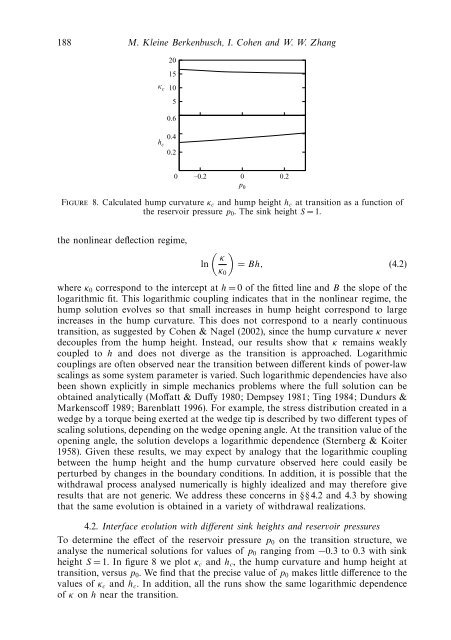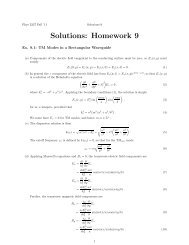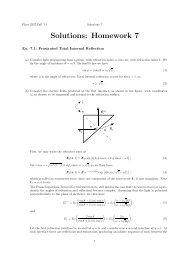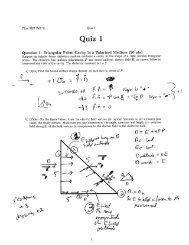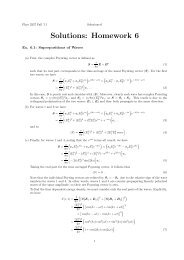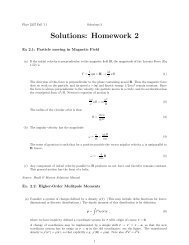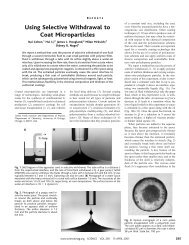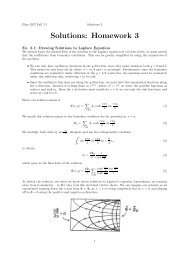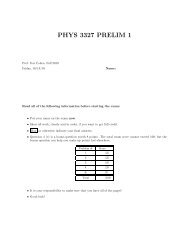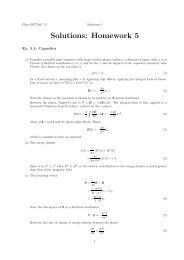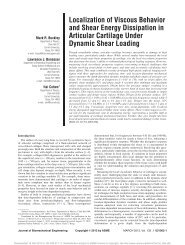Liquid interfaces in viscous straining flows ... - Itai Cohen Group
Liquid interfaces in viscous straining flows ... - Itai Cohen Group
Liquid interfaces in viscous straining flows ... - Itai Cohen Group
Create successful ePaper yourself
Turn your PDF publications into a flip-book with our unique Google optimized e-Paper software.
188 M. Kle<strong>in</strong>e Berkenbusch, I. <strong>Cohen</strong> and W. W. Zhang2015κ c 1050.60.4h c0.2–0.2 0 0.20p 0Figure 8. Calculated hump curvature κ c and hump height h c at transition as a function ofthe reservoir pressure p 0 . The s<strong>in</strong>k height S =1.the nonl<strong>in</strong>ear deflection regime,( ) κln = Bh, (4.2)κ 0where κ 0 correspond to the <strong>in</strong>tercept at h = 0 of the fitted l<strong>in</strong>e and B the slope of thelogarithmic fit. This logarithmic coupl<strong>in</strong>g <strong>in</strong>dicates that <strong>in</strong> the nonl<strong>in</strong>ear regime, thehump solution evolves so that small <strong>in</strong>creases <strong>in</strong> hump height correspond to large<strong>in</strong>creases <strong>in</strong> the hump curvature. This does not correspond to a nearly cont<strong>in</strong>uoustransition, as suggested by <strong>Cohen</strong> & Nagel (2002), s<strong>in</strong>ce the hump curvature κ neverdecouples from the hump height. Instead, our results show that κ rema<strong>in</strong>s weaklycoupled to h and does not diverge as the transition is approached. Logarithmiccoupl<strong>in</strong>gs are often observed near the transition between different k<strong>in</strong>ds of power-lawscal<strong>in</strong>gs as some system parameter is varied. Such logarithmic dependencies have alsobeen shown explicitly <strong>in</strong> simple mechanics problems where the full solution can beobta<strong>in</strong>ed analytically (Moffatt & Duffy 1980; Dempsey 1981; T<strong>in</strong>g 1984; Dundurs &Markenscoff 1989; Barenblatt 1996). For example, the stress distribution created <strong>in</strong> awedge by a torque be<strong>in</strong>g exerted at the wedge tip is described by two different types ofscal<strong>in</strong>g solutions, depend<strong>in</strong>g on the wedge open<strong>in</strong>g angle. At the transition value of theopen<strong>in</strong>g angle, the solution develops a logarithmic dependence (Sternberg & Koiter1958). Given these results, we may expect by analogy that the logarithmic coupl<strong>in</strong>gbetween the hump height and the hump curvature observed here could easily beperturbed by changes <strong>in</strong> the boundary conditions. In addition, it is possible that thewithdrawal process analysed numerically is highly idealized and may therefore giveresults that are not generic. We address these concerns <strong>in</strong> §§4.2 and 4.3 by show<strong>in</strong>gthat the same evolution is obta<strong>in</strong>ed <strong>in</strong> a variety of withdrawal realizations.4.2. Interface evolution with different s<strong>in</strong>k heights and reservoir pressuresTo determ<strong>in</strong>e the effect of the reservoir pressure p 0 on the transition structure, weanalyse the numerical solutions for values of p 0 rang<strong>in</strong>g from −0.3 to0.3 with s<strong>in</strong>kheight S =1.Infigure8weplotκ c and h c , the hump curvature and hump height attransition, versus p 0 . We f<strong>in</strong>d that the precise value of p 0 makes little difference to thevalues of κ c and h c . In addition, all the runs show the same logarithmic dependenceof κ on h near the transition.


